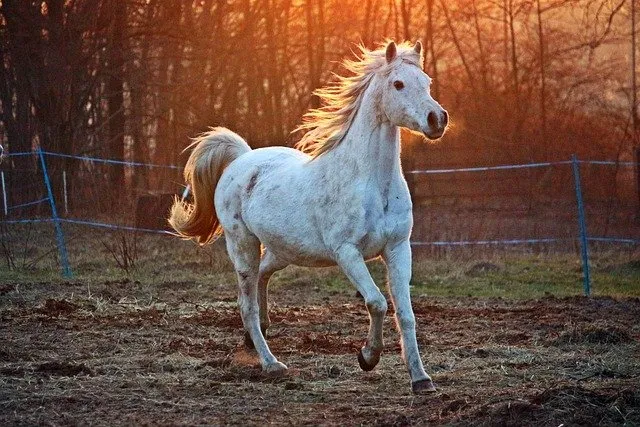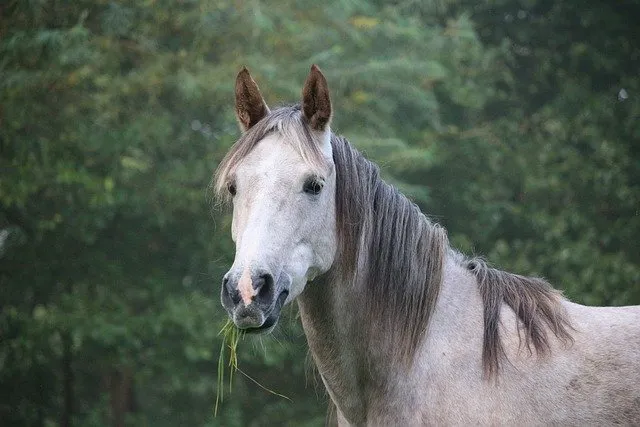As an Amazon Associate I earn from qualifying purchases.
“What do Thoroughbreds eat?” is a question that often perplexes horse owners and enthusiasts, especially those caring for these elegant and high-performance equines. Thoroughbred horses, renowned for their speed and agility, have distinct dietary requirements that play a vital role in their overall health and performance. In this comprehensive blog, we delve into the world of Thoroughbred horse nutrition, exploring their dietary needs, explaining the significance of each food, and offering insights into maintaining their optimal well-being. Whether you’re a seasoned Thoroughbred owner or a curious equestrian, this guide will provide valuable insights into ensuring your Thoroughbred receives the best nourishment possible.
What Do Thoroughbreds Eat?
When caring for Thoroughbred horses, a crucial aspect is their nutrition. Thoroughbreds are known for their speed and agility, making their diet essential to their overall well-being. Here are they:
1. High-Quality Forage:
The foundation of a Thoroughbred’s diet is high-quality forage. This typically comes in grass or legume hay, which provides essential fiber, vitamins, and minerals. Grass hays like timothy or Bermuda grass are good options, especially for Thoroughbreds not in intense training. These hays offer a balanced nutritional profile while being lower in protein, which can help less active horses maintain an appropriate weight. It is essential to include forage in the Thoroughbred’s diet to promote healthy digestion and overall well-being.
2. Concentrated Feeds:
Concentrated feeds play a pivotal role in meeting Thoroughbreds’ energy and nutrient requirements, especially those engaged in rigorous training. These feeds can consist of various grains, including oats, barley, corn, and commercially formulated grain mixes or pellet feeds. Oats are often favored due to their high fiber content and ease of digestion, providing a sustained energy source. Conversely, barley is a more energy-dense option suitable for Thoroughbreds with higher energy needs. Corn should be used sparingly, as it’s a high-energy grain, and excessive consumption can lead to digestive problems.
3. Protein Sources:
Protein is a crucial component of a Thoroughbred’s diet, supporting muscle development and repair, particularly in those engaged in training. Quality protein sources include legumes like alfalfa or clover, which are rich in protein and can be a valuable addition to the diet. However, they should be used judiciously to avoid excess protein intake, which can lead to health issues. Many commercial feeds also incorporate added protein sources, such as soybean meal, ensuring that Thoroughbreds receive an adequate protein intake tailored to their needs and activity level.
4. Supplements:
Supplements can be beneficial in addressing Thoroughbreds’ specific nutritional needs. They include vitamin and mineral mixes, essential micronutrients for overall health, and electrolytes to replenish minerals lost during intense training or in hot weather. Omega-3 fatty acid supplements can support joint health, immune function, and coat condition. It is crucial to ensure that your horse is not over-supplemented. The best way to achieve this is to tailor your horse’s supplement intake to their unique requirements and seek guidance from a qualified veterinarian or equine nutritionist.
5. Fresh Water:
A fundamental aspect of a Thoroughbred’s diet is clean, fresh water. It’s essential for digestion, temperature regulation, and overall well-being. Access to a constant supply of freshwater is non-negotiable for maintaining the health and performance of these horses. Make sure that water sources are clean and uncontaminated, and regularly check that your Thoroughbred is drinking an adequate amount, especially during hot weather or when in training.
6. Monitoring and Adjusting:
Regular monitoring of your Thoroughbred’s weight, activity level, and condition is essential to ensure they receive an optimal diet. Adjustments to their diet should be made as needed to maintain an ideal body condition score. Consulting with a veterinarian or equine nutritionist is advisable for personalized guidance. They can help create a nutrition plan tailored to your horse’s needs, ensuring they stay in prime condition and can excel in their respective activities. Remember that each horse is unique, and their dietary requirements may vary, so a personalized approach is key to their well-being.
How To Feed Thoroughbreds?
Feeding Thoroughbreds effectively is crucial to their care, especially given their high-performance nature. Proper nutrition can influence their health, energy levels, and performance. Here, we’ll delve into feeding Thoroughbreds, outlining the process and sharing some tricks to ensure they receive the best nutrition.
1. Evaluate Individual Needs:
Each Thoroughbred has unique activity levels, age, and health status. The first step in feeding Thoroughbreds is evaluating their specific requirements. This assessment should consider factors like body weight, body condition score, age, exercise intensity, and health issues. Some horses may need a diet geared toward weight gain, while others require maintenance or reduced calorie intake.
2. Quality Forage as a Foundation:
High-quality forage, such as grass hay or legume hay, forms the foundation of a Thoroughbred’s diet. Forage provides essential fiber, vitamins, and minerals. Grass hay varieties like timothy or Bermuda grass are often preferred for Thoroughbreds, especially those not involved in intense training. Legume hays, like alfalfa, can be included but should be used judiciously due to their higher protein content.
3. Feeding Schedule:
Establish a consistent feeding schedule, providing meals simultaneously each day. This routine helps prevent digestive upset and establishes predictability for your horse. Typically, Thoroughbreds are fed two to three meals a day, with the largest portion given after exercise to aid recovery.
4. Monitor and Adjust:
Regularly monitor your Thoroughbred’s condition, weight, and activity level. Adjust their diet as needed to maintain an ideal body condition score. Consult with a veterinarian or equine nutritionist to create a personalized nutrition plan, especially if you’re uncertain about your horse’s needs.
5. Keep a Watchful Eye:
Observing your Thoroughbred’s behavior and health is critical. Look for signs of changes in appetite, weight, energy levels, coat condition, and unusual behavior. This can help you detect and address nutritional issues early.
6. Avoid Rapid Dietary Changes:
Sudden dietary changes can cause digestive upset. Gradually alter your Thoroughbred’s diet over several days to give their digestive system time to adjust.
When To Feed Thoroughbreds?
Feeding Thoroughbreds is not just about what they eat; it also involves when they eat. Establishing and maintaining a regular feeding schedule is critical to their care, as it plays a significant role in their overall health, digestion, metabolism, and behavior. In this discussion, we’ll explore the timing of feeding Thoroughbreds and the crucial reasons behind the importance of adhering to a consistent feeding schedule.
When to Feed Thoroughbreds:
Morning Feeding: Thoroughbreds typically receive their first meal of the day in the morning, often called the “breakfast” feed. This morning meal gives them the energy and nutrients to start their day and engage in various daily activities.
Lunch or Midday Feeding (Optional): Some Thoroughbreds with higher energy demands, especially those engaged in intense training or competition, may benefit from an optional midday feeding. This supplementary meal provides additional calories and essential nutrients, catering to their increased energy requirements.
Evening Feeding: The evening meal is usually given in the late afternoon or early evening, commonly after training or exercise. This feeding plays a crucial role in post-exercise recovery and replenishing the horse’s energy stores, ensuring sufficient fuel for the night ahead.
Why It’s Important to Maintain a Feeding Schedule:
Digestive Health: Horses, including Thoroughbreds, have highly sensitive digestive systems that have evolved to function optimally with regularity. Feeding on a consistent schedule helps maintain a stable pH in the stomach and ensures the smooth operation of the entire digestive tract. Deviating from a structured feeding routine can lead to digestive issues, including colic, a potentially life-threatening condition.
Metabolism and Energy: A regular feeding schedule plays a vital role in stabilizing a Thoroughbred’s metabolism. It allows for the predictable production and expenditure of energy. This stability is essential for maintaining a healthy body weight and providing energy when needed, such as during training or physical activity.
Behavior and Routine: Horses are known for their preference for routine and predictability. Consistent feeding times give Thoroughbreds a sense of security and predictability, reducing stress and anxiety. Horses that follow a routine are generally more content and manageable, contributing to their overall well-being.
Final Words
Understanding “what do Thoroughbreds eat?” and how to feed them is integral to providing optimal care for these magnificent equine athletes. We’ve explored the intricacies of their dietary requirements, the importance of a consistent feeding schedule, and the significance of each food component. Thoroughbred owners and enthusiasts can help these horses maintain their health, performance, and well-being by prioritizing high-quality forage, balanced, concentrated feeds, and regular access to fresh water. Whether you’re a seasoned Thoroughbred owner or someone looking to enhance their knowledge, this comprehensive guide is a valuable resource to ensure your Thoroughbred receives the nourishment it needs to thrive.
You can also read:
1.What Do Silkie Chickens Eat? A Guide to Their Dietary Needs
2.What Do Schnauzers Eat? Nourishing Your Schnauzer
3.What Do Gray Whales Eat? A Deep Dive into Their Diet
4.What Do Belgian Malinois Eat? A Diet Guide for Optimal Health
Amazon and the Amazon logo are trademarks of Amazon.com, Inc, or its affiliates.



